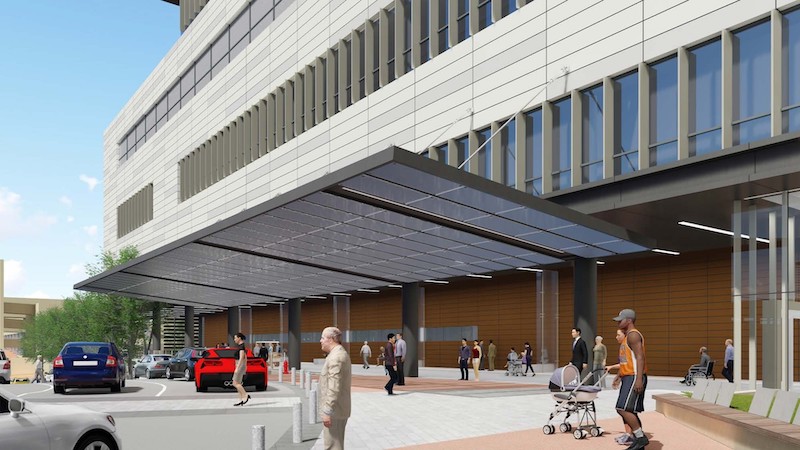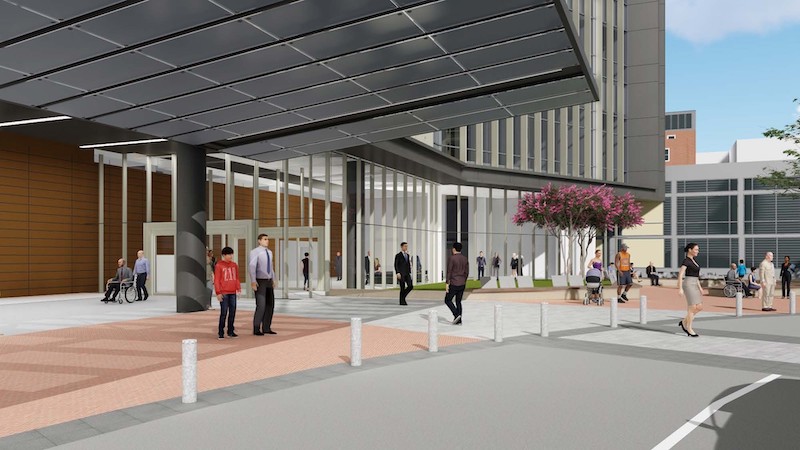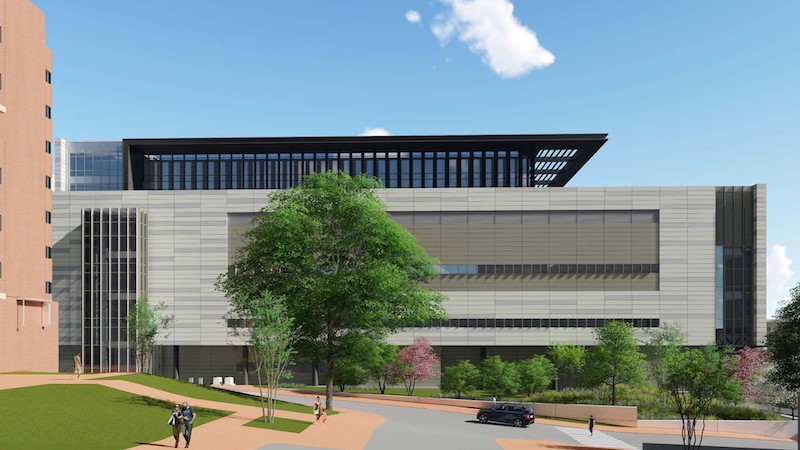Set to become the largest building on UNC Hospitals Chapel Hill campus, the new 335,000-sf Surgical Tower will enhance UNC Health Care’s ability to provide surgical and medical care for Carolina residents.
The seven-story tower will feature 24 operating rooms, two hybrid operating rooms, 56 pre- and post-operating rooms, and two floors of ICU space with 56 beds. The building will also include a basement level, a main reception and visitor waiting areas on each floor, offices and conference rooms, an indoor and outdoor staff lounge, and staff locker rooms.

Patient drop-off canopies at the Surgical Tower and the existing Children’s Hospital will also be built. Two overhead pedestrian bridges will connect existing parking decks and the Dental School building to the Surgical Tower. Finally, the project will include a three-story service connector, renovation work at the existing Ambulatory Patient Care Facility, and the expansion of the cafe in the existing part of the hospital.

The project, which is being built by Skanska, will be constructed in three phases. Phase one will include site development work and the new connector basement construction, phase two will focus on deep foundation construction, and phase three will focus on the main Surgical Tower building work.
See Also: Design unveiled for the University of Maryland’s School of Public Policy building

Phase one’s site development will include extensive utility relocations, an upgraded storm and sanitary system, new chilled water and steam for the tower and adjacent buildings, and new electrical duct bank from a future generator plant.
The project is slated for completion in 2022.


Related Stories
| Dec 30, 2014
The future of healthcare facilities: new products, changing delivery models, and strategic relationships
Healthcare continues to shift toward Madison Avenue and Silicon Valley as it revamps business practices to focus on consumerism and efficiency, writes CBRE Healthcare's Patrick Duke.
| Dec 29, 2014
HDR and Hill International to turn three floors of a jail into a modern, secure healthcare center [BD+C's 2014 Great Solutions Report]
By bringing healthcare services in house, Dallas County Jail will greatly minimize the security risk and added cost of transferring ill or injured prisoners to a nearby hospital. The project was named a 2014 Great Solution by the editors of Building Design+Construction.
| Dec 29, 2014
New mobile unit takes the worry out of equipment sterilization during healthcare construction [BD+C's 2014 Great Solutions Report]
Infection control, a constant worry for hospital administrators and clinical staffs, is heightened when the hospital is undergoing a major construction project. Mobile Sterilization Solutions, a mobile sterile-processing department, is designed to simplify the task. The technology was named a 2014 Great Solution by the editors of Building Design+Construction.
| Dec 29, 2014
HealthSpot station merges personalized healthcare with videoconferencing [BD+C's 2014 Great Solutions Report]
The HealthSpot station is an 8x5-foot, ADA-compliant mobile kiosk that lets patients access a network of board-certified physicians through interactive videoconferencing and medical devices. It was named a 2014 Great Solution by the editors of Building Design+Construction.
BIM and Information Technology | Dec 28, 2014
The Big Data revolution: How data-driven design is transforming project planning
There are literally hundreds of applications for deep analytics in planning and design projects, not to mention the many benefits for construction teams, building owners, and facility managers. We profile some early successful applications.
| Dec 28, 2014
AIA course: Enhancing interior comfort while improving overall building efficacy
Providing more comfortable conditions to building occupants has become a top priority in today’s interior designs. This course is worth 1.0 AIA LU/HSW.
| Dec 2, 2014
Nonresidential construction spending rebounds in October
This month's increase in nonresidential construction spending is far more consistent with the anecdotal information floating around the industry, says ABC's Chief Economist Anirban Basu.
| Dec 1, 2014
How public-private partnerships can help with public building projects
Minimizing lifecycle costs and transferring risk to the private sector are among the benefits to applying the P3 project delivery model on public building projects, according to experts from Skanska USA.
| Nov 25, 2014
Emerging design and operation strategies for the ambulatory team in transition
As healthcare systems shift their care models to be more responsive to patient-centered care, ambulatory care teams need to be positioned to operate efficiently in their everyday work environments, write CannonDesign Health Practice leaders Tonia Burnette and Mike Pukszta.
| Nov 20, 2014
Lean Led Design: How Building Teams can cut costs, reduce waste in healthcare construction projects
Healthcare organizations are under extreme pressure to reduce costs, writes CBRE Healthcare's Lora Schwartz. Tools like Lean Led Design are helping them cope.

















